A boat “on the hard”, hauled out for storage or repairs, is in a state of suspended animation. Water gives a boat life and purpose. She is not meant to lie idle, immobilized by blocks and stands, hemmed in by scaffolding and ladders. The longer she is out of the water the greater the chance becomes that she may never go back in, that her days may end in the back corner of a gravel lot somewhere, with her bilges filled with rain water and blackberry vines growing through her sides and decks.
When I took on the project of saving Petrel, the abandoned troller I found in South Park Marina, my plan was to give her a quick coat of paint and get her back in the water. I thought it would take three or four weeks in the yard, maybe six at the outside. But first I had to clean out all the garbage from the inside and scrub off the green slime that covered her from cabin tops to keel.
Beginning with the aft cabin, I removed rusty tools, dirty dishes stacked in the sink, miscellaneous pieces of rotting rope, drawers full of condiments long past their expiration date, mildewed curtains, boxes of hardware, an old radar set, soggy cushions and more. I spent two days clearing out the interior, and that was the easy part.
With the interior somewhat clean, I was faced with the job of removing the thick layer of algae that covered every exterior surface. Armed with a pressure washer and determination, I spent a long day scrubbing green slime from cabin tops, cabin sides, decks, bulwarks, scuppers, portlights, hatches, handrails, windows, doors, stem, stern, and topsides.
Eight hours later Petrel was clean. She was still shabby, neglected, in need of paint, and with doubtful prospects but, like a stray puppy after a bath, she now looked like she was worth saving. I, on the other hand, was filthy, tired, and soaking wet, but happy to be making progress.
The next project was to assess the work that would be needed before Petrel could go back in the water. So I surveyed the boat to locate soft wood, deteriorating fasteners, failing hardware and any other problems. The good news was that the hull appeared to be generally tight and sound. Tapping the hull with a mallet revealed no soft spots below the waterline. There were no sprung butts, loose planks or gaping seams. But the list of problems was still a dash of cold water. I found frames deteriorated from the interaction between the iron fasteners and rot in the bulwarks that extended into the hull planking. Her engine was covered in rust. Every part of her suffered from years of weather and neglect. Petrel would need a lot of work.
The pages of WoodenBoat magazine are filled with inspirational tales of expert craftsmen bringing old boats back to life with dedication, perseverance and artistry in wood. But I did not have that skill or expertise, so the restoration of Petrel would not be one of those stories.
There are other examples of people with little experience but great determination taking a derelict old hull and turning it into a work of art. These acts of passion are amazing to watch as the inexperienced owners overcome every obstacle through sheer will and refusal to accept anything less than perfection. But my efforts with Petrel would not be one of those stories either.
Having spent the better part of four decades living on, cruising and maintaining wooden boats I thought I knew something about them. But it was an amateur’s knowledge. Thin, full of gaps and based largely on trial and (much) error. So the effort to restore Petrel was always going to be a story of compromise, quick fixes and questionable techniques. It would certainly involve epoxy filler in places where fine joinery would be preferred. It might resort to duct tape.
By this point it was already clear that my plan for a quick paint job and relaunch in the spring was not going to happen. I worked on Petrel in the early mornings and on weekends, making the half hour drive to south Seattle before sunrise to steal a few hours away from work and family commitments. Abandoning my timeline and my expectations, I found enjoyment in just making whatever progress I could. Petrel was improving, and that was enough.
I made temporary repairs to the rotten bulwarks and hull planking by digging out the rot, patching the holes with plywood, and filling the gaps with epoxy. A proper repair would be needed at some point but it wasn’t the top priority. With that done I had hoped to do a quick coat of paint and launch but my inspection of the hull showed me that was only wishful thinking. Between the bleeding fastenings and general weathering there wasn’t enough left of the previous finish to hold another layer of paint. The only option was to strip it all off and start again.
Through the spring and summer of 2015 I stripped the topsides with a heat gun and scraper, then with a power sander, removing years of accumulated paint. I spent Saturdays at the boat yard, eating lunch at the Mexican restaurant a few blocks away alongside the guys from the tire repair shop across the street, or Sicilian-style pizza from the cafe run by a family from New York. By September, after three months of grinding work, the old finish was gone, revealing solid, old-growth cedar planking. Petrel was starting to look like a boat with a future.
In between sessions of paint scraping I tackled other projects. A previous owner had built a cabin over the fish hold to give Petrel more room below, but it was rotten where water had leaked in and it had to be demolished. I spent a weekend cutting it up and building a temporary aft deck where it had been. I made no attempt to create a proper deck, with cambered oak beams, carlin joints, and marine plywood. My only goal was to get Petrel in the water so I threw together a rough platform from lumber yard two-by-fours and particle board, just to have something to walk on.
I was progressing toward a launch date for Petrel but October loomed, bringing the threat of rain. I needed to get paint on the hull before the weather turned or I would be stuck in the yard fighting with tarps and puddles until spring. So through September and October I spent mornings and weekends applying primer to the hull, then several coats of dark green paint, finished off with a cream stripe above the rub rail. I completed the job by painting the bottom, traditional dark red, in a cold November rain.
It wasn’t the perfect job I would have liked to do. There were drips, and runs, and places left unfinished, and colored outside the lines, but it was done. Petrel was ready to go back in the water. A few days later she was launched, just as the first winter rain storm swept in from the Pacific, soaking the boat, the yard, the crew, the dock, the new paint, the whole city… and I didn’t care. Petrel was in the water, floating for the first time in over a year.
She lay at the dock looking shabby with her peeling cabin paint. She leaked, as any wooden boat will do after drying out for a year, but two pumps just kept up with the water coming in through the dried out seams. I still had no idea if the engine would run or if she would sink at her moorings the next day, but right then I didn’t care about any of those things. She was floating. Our year on the hard was over.


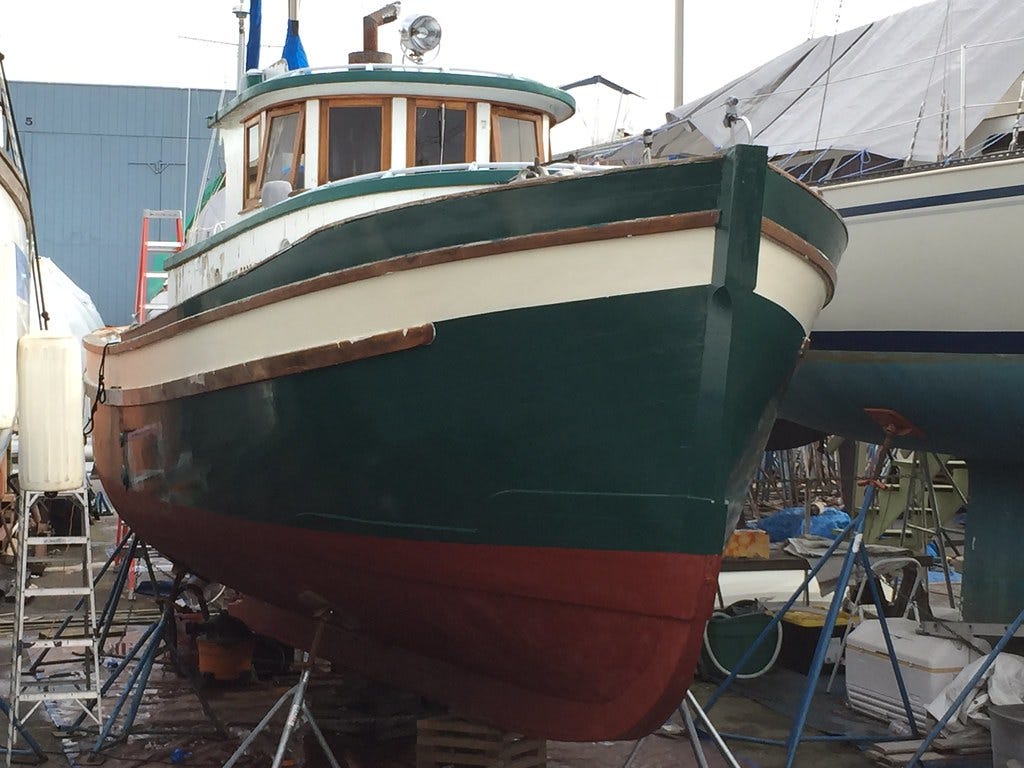
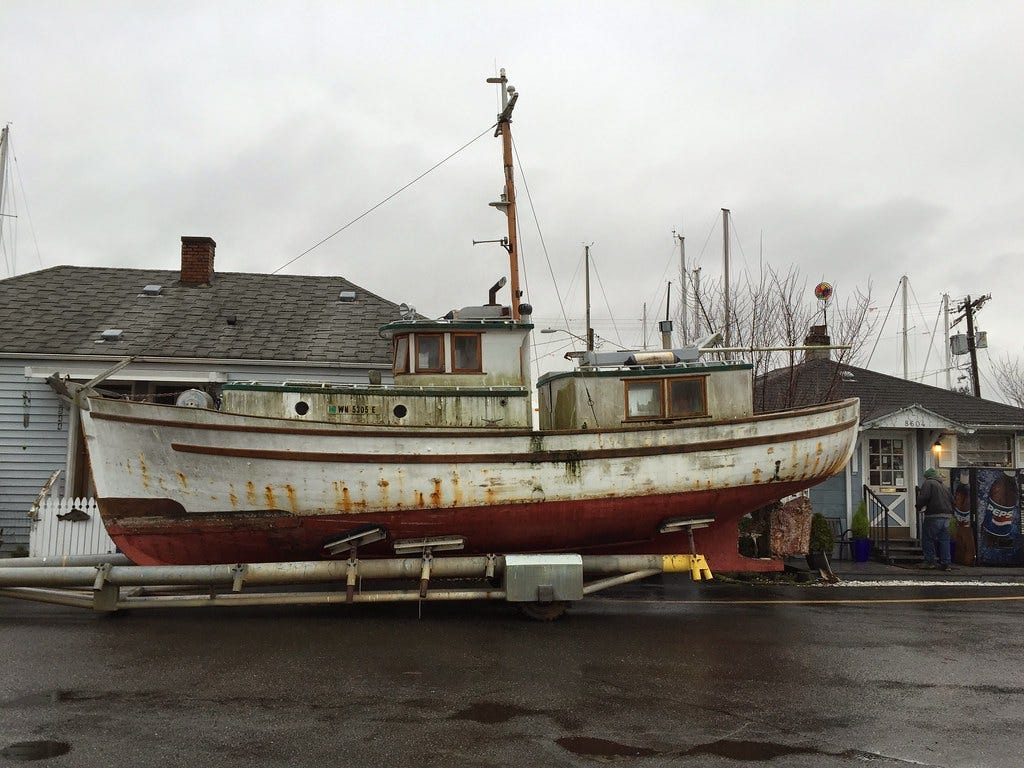

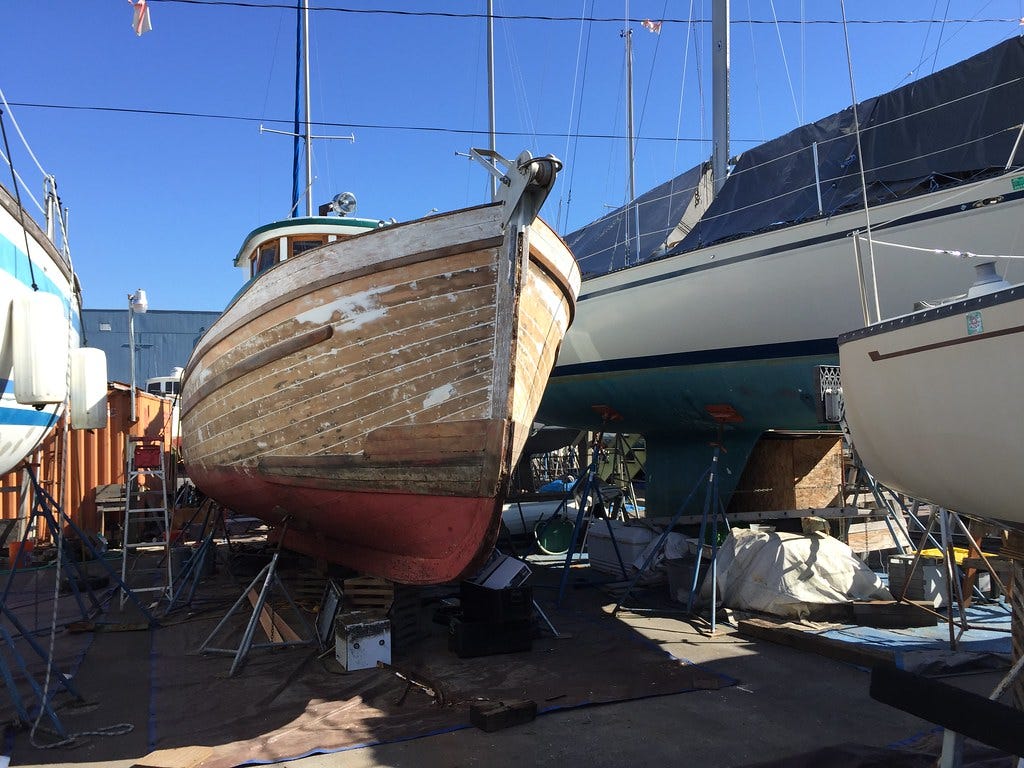
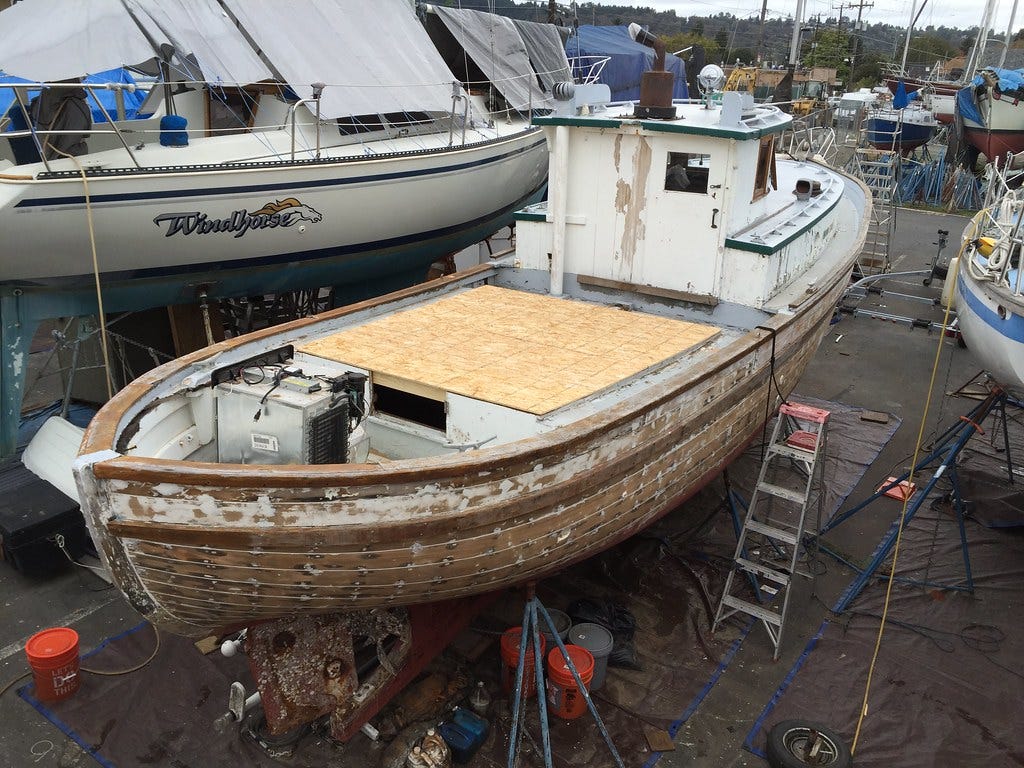

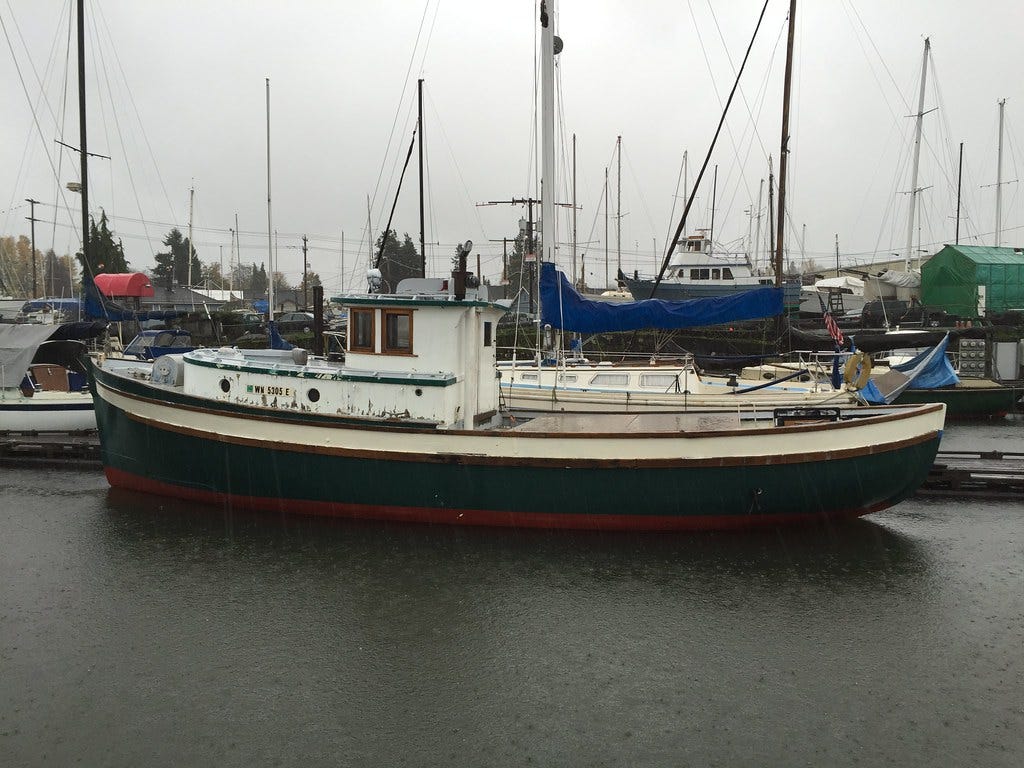
For all her shabbiness, Petrel is a handsome vessel, as a double-ender can be when drawn by someone with a good eye. As for all those DIY projects written up in WoodenBoat, ignore them (as, in your wisdom, I'm sure you do). Jon Wilson's agenda was to raise awareness of the beauty of wood boats, which he did, using articles about restoration and with gorgeous photography by the likes of Ben Mendlowitz. I have no objection to the WB propaganda because I fully endorse the project. But I do take the "perfect restoration" articles with a grain of salt. Your Saltwater Journal articles are much closer to the reality of wood boat ownership and valuable for that.